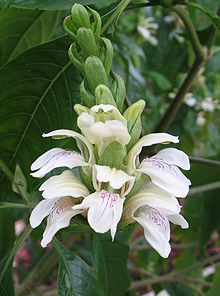Justicia adhatoda: Difference between revisions
| Line 40: | Line 40: | ||
*[[Hindi language|Hindi]] : Adosa, Arusha, Rus, Bansa |
*[[Hindi language|Hindi]] : Adosa, Arusha, Rus, Bansa |
||
*[[Bengali language|Bengali]] : Adulsa, Bakash |
*[[Bengali language|Bengali]] : Adulsa, Bakash |
||
*[[ |
*[[Gujarati language|Gujarati]] : Adulso, Aduraspee, Bansa |
||
*[[Kannada language|Kannada]] : Adusogae |
*[[Kannada language|Kannada]] : Adusogae |
||
*[[Marathi language|Marathi]] : Adulsa, Adusa |
*[[Marathi language|Marathi]] : Adulsa, Adusa |
||
Revision as of 09:20, 14 November 2010
| Justicia adhatoda | |
|---|---|

| |
| Scientific classification | |
| Kingdom: | |
| Division: | |
| Class: | |
| Order: | |
| Family: | |
| Genus: | |
| Species: | J. adhatoda
|
| Binomial name | |
| Justicia adhatoda | |
Justicia adhatoda L. (Adulsa, Malabar Nut); syn. Adhatoda vasica Nees ,(sanskrit : अडुसा adusa, aruha, अरुष arusha, arusak, अटरुष atrusha, basak, भिशाङगमाता bhishangamata, कफाहारी kaphahari, सिंही simhi, सिंहिका simhika, सिंहपर्णी sinhaparni, सिंहमुखी simhamukhi, vaidya mata, vajeedantaka, vansa, वासा vasa, वासक vasaka.) is a medicinal plant native to Asia.
The plant grows wild in abundance all over Nepal, India, and the Pothohar region of Pakistan, particularly in the Pharwala area, within Pakistan it is the Provincial flower of the Punjab (Pakistan).
Botanical Description
Adhatoda consists of the fresh or dried leaves of Adhatoda Vasica, Nees (N.O. Acanthaceae), a shrub growing in India. The leaves vary from 10 to 15 centimeters in length, and are about 4 centimeters broad; they are opposite, entire, lanceolate, and shortly petiolate, tapering towards both apex and base. When dry they are of a dull brownish-green colour; odour, characteristic; taste, bitter. They possess well-marked histological features, which can easily be seen in fragments of the leaf cleared by chloral hydrate. The stomata are elongated-oval in shape and surrounded by two crescent-shaped cells, the long axes of which are at right angles to the ostiole. The epidermis bears simple one- to three-celled warty hairs, and small glandular hairs with a quadricellular secreting gland. Cystoliths occur beneath the epidermis of the under surface. Both hairs and cystoliths vary in number in different specimens
Chemical Composition
Several alkaloids are present in the leaves and the chief principle is a quinazoline alkaloid, vasicine; the yield of the alkaloid from different samples in India ranged from 0.541 to 1.105 per cent on dry basis. Vasicine is accompanied by l- vasicinone., deoxyvasicine and maiontone, Some minor alkaloids viz. Vasicol, adhatodinine and vasicinol also present.
Pharmacology and Action
- Antiasthmatic,
- Antispasmodic (respiratory tract),
- Bronchodilator,
- Expectorant (relaxing),
- Oxytocic.
The pharmacological activities of vasicine and vasicinone are well known. The /-forms of vasicine and vasicinone are more active than their racemic forms. Recent investigations on vasicine showed bronchodilatory activity (comparable to theophylline) both in vitro and in vivo. Vasicinone showed bronchodilatory activity in vitro but bronchoconstrictory activity in vivo; it is probably biotransformed in vivo, causing bronchoconstriction. Both the alkaloids in combination (1:1) showed pronounced bronchodilatory activity in vivo and in vitro. Vasicine also exhibited strong respiratory stimulant activity, moderate hypotensive activity and cardiac-depressant effect; vasicinone was devoid of these activities. The cardiac-depressant effect was significantly reduced when a mixture of vasicine and vasicinone was used. Vasicinone (dl-form) showed no effect on the isolated heart, but probably the l-form is a weak cardiac stimulant. Clinical trials of a commercial drug containing vasicinone and vasicinone have not revealed any side effects while treating bronchial asthma. The drug is known to possess abortifacient activity nd hence should not be used during pregnancy.
Names
It is also called Adhatoda vasika and has different names in different Indian languages.[1]
- Sanskrit : Sinhapuri, Vasaka (वसाका)
- Hindi : Adosa, Arusha, Rus, Bansa
- Bengali : Adulsa, Bakash
- Gujarati : Adulso, Aduraspee, Bansa
- Kannada : Adusogae
- Marathi : Adulsa, Adusa
- Malayalam : Ataloetakam
- Persian : Bansa
- Punjabi : Bhekkar
- Tamil : Adhatoda
- Telugu : Adamkabu, Adampaka, Addasaram (అడ్డసరం)
References
- ^ Dr. K. M. Nadkarni's Indian Materia Medica, Volume 1, Edited by A. K. Nadkarni, Popular Prakashan, Bombay, 1976, pp. 40.
External links
